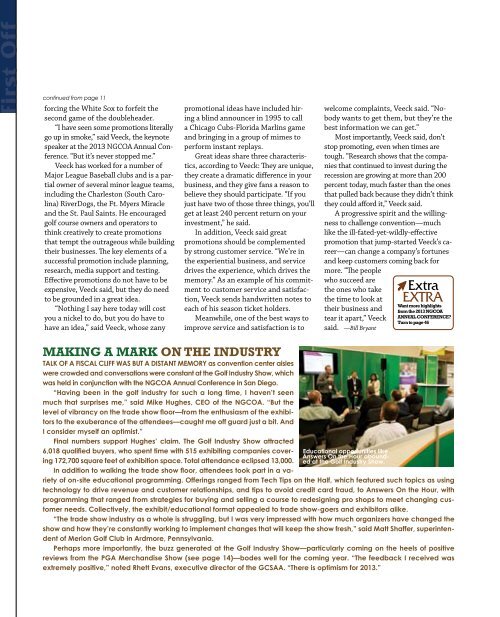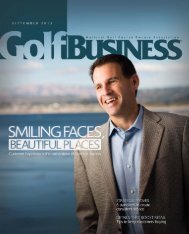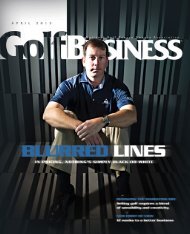Community - GolfBusiness
Community - GolfBusiness
Community - GolfBusiness
You also want an ePaper? Increase the reach of your titles
YUMPU automatically turns print PDFs into web optimized ePapers that Google loves.
First Off<br />
continued from page 11<br />
forcing the White Sox to forfeit the<br />
second game of the doubleheader.<br />
“I have seen some promotions literally<br />
go up in smoke,” said Veeck, the keynote<br />
speaker at the 2013 NGCOA Annual Conference.<br />
“But it’s never stopped me.”<br />
Veeck has worked for a number of<br />
Major League Baseball clubs and is a partial<br />
owner of several minor league teams,<br />
including the Charleston (South Carolina)<br />
RiverDogs, the Ft. Myers Miracle<br />
and the St. Paul Saints. He encouraged<br />
golf course owners and operators to<br />
think creatively to create promotions<br />
that tempt the outrageous while building<br />
their businesses. The key elements of a<br />
successful promotion include planning,<br />
research, media support and testing.<br />
Effective promotions do not have to be<br />
expensive, Veeck said, but they do need<br />
to be grounded in a great idea.<br />
“Nothing I say here today will cost<br />
you a nickel to do, but you do have to<br />
have an idea,” said Veeck, whose zany<br />
promotional ideas have included hiring<br />
a blind announcer in 1995 to call<br />
a Chicago Cubs-Florida Marlins game<br />
and bringing in a group of mimes to<br />
perform instant replays.<br />
Great ideas share three characteristics,<br />
according to Veeck: They are unique,<br />
they create a dramatic difference in your<br />
business, and they give fans a reason to<br />
believe they should participate. “If you<br />
just have two of those three things, you’ll<br />
get at least 240 percent return on your<br />
investment,” he said.<br />
In addition, Veeck said great<br />
promotions should be complemented<br />
by strong customer service. “We’re in<br />
the experiential business, and service<br />
drives the experience, which drives the<br />
memory.” As an example of his commitment<br />
to customer service and satisfaction,<br />
Veeck sends handwritten notes to<br />
each of his season ticket holders.<br />
Meanwhile, one of the best ways to<br />
improve service and satisfaction is to<br />
welcome complaints, Veeck said. “Nobody<br />
wants to get them, but they’re the<br />
best information we can get.”<br />
Most importantly, Veeck said, don’t<br />
stop promoting, even when times are<br />
tough. “Research shows that the companies<br />
that continued to invest during the<br />
recession are growing at more than 200<br />
percent today, much faster than the ones<br />
that pulled back because they didn’t think<br />
they could afford it,” Veeck said.<br />
A progressive spirit and the willingness<br />
to challenge convention—much<br />
like the ill-fated-yet-wildly-effective<br />
promotion that jump-started Veeck’s career—can<br />
change a company’s fortunes<br />
and keep customers coming back for<br />
more. “The people<br />
who succeed are<br />
the ones who take Extra<br />
the time to look at Extra<br />
Want more highlights<br />
their business and<br />
from the 2013 NGCOA<br />
tear it apart,” Veeck<br />
Annual Conference<br />
Turn to page 46<br />
said. —Bill Bryant<br />
Educational opportunities like<br />
Answers On the Hour abounded<br />
at the Golf Industry Show.<br />
MAKING A MARK ON THE INDUSTRY<br />
TALK OF A FISCAL CLIFF WAS BUT A DISTANT MEMORY as convention center aisles<br />
were crowded and conversations were constant at the Golf Industry Show, which<br />
was held in conjunction with the NGCOA Annual Conference in San Diego.<br />
“Having been in the golf industry for such a long time, I haven’t seen<br />
much that surprises me,” said Mike Hughes, CEO of the NGCOA. “But the<br />
level of vibrancy on the trade show floor—from the enthusiasm of the exhibitors<br />
to the exuberance of the attendees—caught me off guard just a bit. And<br />
I consider myself an optimist.”<br />
Final numbers support Hughes’ claim. The Golf Industry Show attracted<br />
6,018 qualified buyers, who spent time with 515 exhibiting companies covering<br />
172,700 square feet of exhibition space. Total attendance eclipsed 13,000.<br />
In addition to walking the trade show floor, attendees took part in a variety<br />
of on-site educational programming. Offerings ranged from Tech Tips on the Half, which featured such topics as using<br />
technology to drive revenue and customer relationships, and tips to avoid credit card fraud, to Answers On the Hour, with<br />
programming that ranged from strategies for buying and selling a course to redesigning pro shops to meet changing customer<br />
needs. Collectively, the exhibit/educational format appealed to trade show-goers and exhibitors alike.<br />
“The trade show industry as a whole is struggling, but I was very impressed with how much organizers have changed the<br />
show and how they’re constantly working to implement changes that will keep the show fresh,” said Matt Shaffer, superintendent<br />
of Merion Golf Club in Ardmore, Pennsylvania.<br />
Perhaps more importantly, the buzz generated at the Golf Industry Show—particularly coming on the heels of positive<br />
reviews from the PGA Merchandise Show (see page 14)—bodes well for the coming year. “The feedback I received was<br />
extremely positive,” noted Rhett Evans, executive director of the GCSAA. “There is optimism for 2013.”




